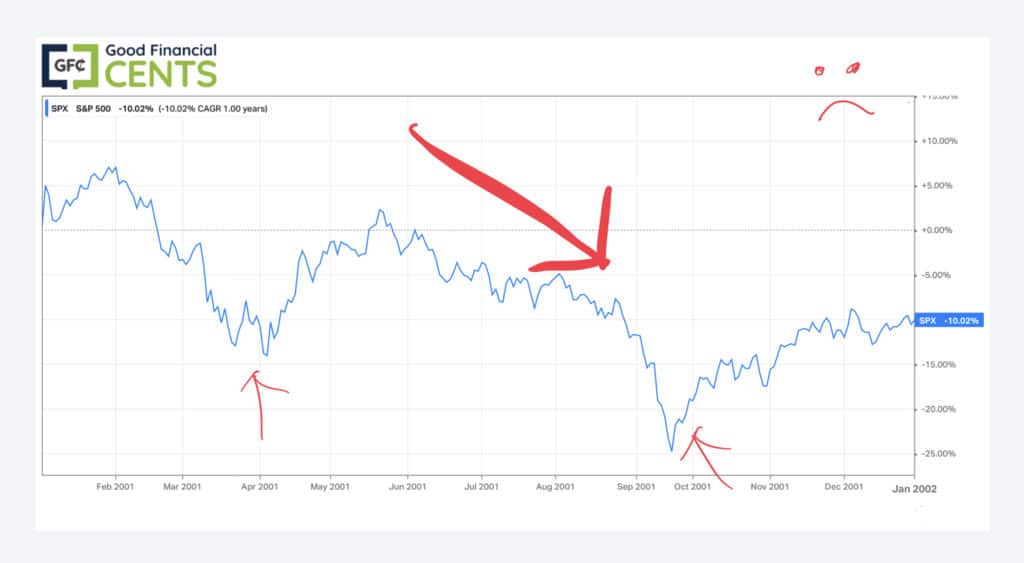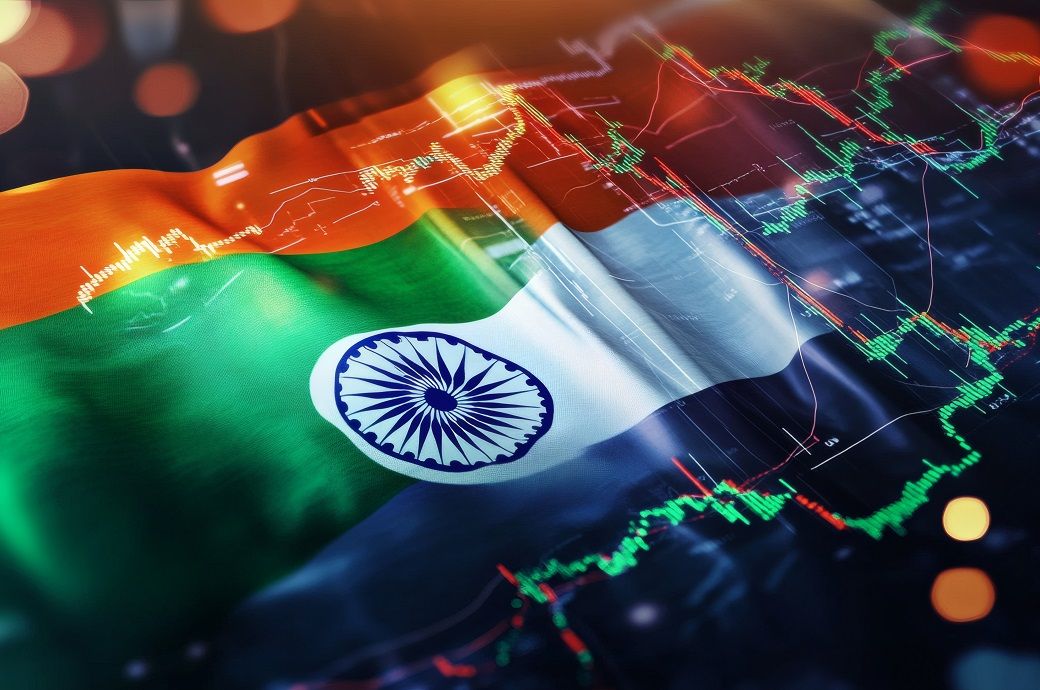I was a college intern at a local investment firm when I first learned what a “stock market crash” was. It was 2001 and the market was already on the decline. After the tragic events of 9/11, the stock market continued to lose value.
Here’s how the S&P 500 looked in 2001 (chart courtesy of Koyfin.com):

The chart above may show what the stock market crash “looked” like but I assure you it doesn’t capture what it felt like.
The look of defeat on the financial advisors I was working with could not go unnoticed. For those that lived it you know the crash didn’t stop in 2001. It continued well into 2002 erasing millions of wealth in our country.
I thought that was the stock market crash I would ever witness in my life. That was until 2008…
New investors often think of stock market crashes as rare events when in fact, the opposite is true. The market experiences a crash every few years. While the COVID Crash of 2020 might have been a nightmare in its own right, it’s far from the worst crash ever.
That one was so short-lived that you probably don’t even remember it happened. But since I experienced 2 stock market crashes fairly close to each other and recognizing it has been over 13+ years since anyone has experienced a really severe down market, I thought it would be a good idea to warn new investors. Especially for those that started investing with online apps or brokers that have only seen green when they check their accounts.
To put the stock market crash factor into perspective, I’ve put together this list of the top 10 worst stock market crashes in history.
As you’ll see, stock market crashes come in all shapes and sizes, and they’re even common throughout history. This list goes on the way back to 1907, which goes to show you how long crashes have been taking place.
What is a Stock Market Crash?
A stock market crash is a noticeably rapid decline in share prices. Stocks normally fluctuate, even within the same day.
There could even be identifiable patterns, like the market rising on a few percentage points one week, then falling a few the next. It all balances out, and either the market continues to rise, or stays in a narrow trading pattern.
We can think of a crash as being a disturbance in the normal pattern.
Rather than repeating the cycle of short-term advances and declines, the market goes into a deep dive.
There’s no specific definition of what a stock market crash is, and they’re often labeled well after the fact. But a stock market crash can be seen as an unusually large decline in the market, typically happening within a short time frame.
The Different Causes of Stock Market Crashes
Market crashes can come about because of extended gains, which can last over many years. These are sometimes referred to as bubbles, that can come crashing down when valuations get too high. A good example of this was the Dot-com Bust in 2000 (which only made #8 on this list).
Losses in that crash were concentrated in technology stocks that reached levels that have nothing to do with their financial fundamentals. What happened afterward was totally predictable, even though it didn’t seem obvious at the time
Other times, market crashes are caused by major events. Examples include the World War II Crash (#7 below) and the Crash of 2020 (#10). One was caused by a world war, and the other by a global pandemic.
Like market bubbles, market crashes last until they peter out. That’s usually brought about by a combination of stock prices falling to more reasonable levels, and some combination of positive developments that reverse the negativity that caused or contributed to the crash.
The upshot is that each crash sets up the next boom. For that reason, we should think of crashes as an opportunity to buy stocks at deep discounts.
What’s the Difference Between a Stock Market Crash and a Bear Market?
It can be difficult to establish the dividing line between a stock market crash and a bear market. This is mostly because the end result is the same – most investors lose money, and usually a lot of it.
But the main factor separating the two is duration. Crashes tend to be short and sharp. For example, the market may lose 30% in just two or three months. Or in the case of the Crash of 1987 (#9), it may last only a few weeks.
There have been crashes that lasted only a few days. These are what are often referred to as flash crashes.
Bear markets, on the other hand, tend to last longer. Generally, they’ll go at least one year, but can often run for two or three.
Some bear markets, like the Crash of 1929, lasted for several years, and include a series of crashes.
This gray zone between stock market crashes and bear markets also explains why there are different lists on what makeup the biggest crashes in history.
Top 10 WORST Stock Market Crashes in History
Our list of the top 10 worst stock market crashes in history takes in every identifiable crash since 1900. In most cases, I’ve used the Dow Jones Industrial Average to determine the percentage decline and duration of each crash.
That’s because it was the primary measure of the stock market, at least until the 1970s, when the S&P 500 and the NASDAQ started becoming more standard measures.
Here are the top 10 stock market crashes in history:
1. September 3, 1929 to July 8, 1932
Percentage Decline: 89.2%
Duration: 34 months
Without a doubt, this crash is the worst in stock market history. It was the first of a series of crashes that occurred during the 1930s and early 1940s, during the time commonly referred to as the Great Depression.
What made the Crash of 1929 so severe was that it followed a decade of double-digit annual returns in the stock market. From there, the crash took hold suddenly. Between September 3, and November 13, the market lost 45% of its value in just over two months. That likely qualifies as the single biggest flash crash in history. Unfortunately, that moved the market only halfway to its ultimate bottom.
The worst part of the crash happened during three single trading days. October 24, which became known as Black Thursday, saw the market lose 11% of its value on heavy trading.
That was followed by Black Monday, on October 28 – just two trading days later. On that day the market gave up another 12.8%.
The punch-drunk market was hit hard on the very next day, Black Tuesday, with the market giving up 11.7%. Total market losses for just two days hit 25%. That formed the biggest two-day loss in stock market history.
Efforts by wealthy investors to inject cash into the market and prop up prices failed. Many stocks trading on the New York Stock Exchange had no buyers at all, creating a worst-case scenario. Hundreds of companies filed for bankruptcy after the crash.
The Crash of 1929 – By the Numbers
From start to finish, the Dow Jones Industrial Average experienced the biggest bear market in history. After peaking at 381.17 on September 3, 1929, the Dow Jones Industrial average hit bottom at 41.22 on July 8, 1932. That resulted in an overall loss of 89.2%.
The decline was so steep that it would take until November 23, 1954, before the index would finally recover to its precrash high. Put another way, if you were invested in the market in September 1929, it would’ve taken just over 25 years for your portfolio to fully recover.
2. March 6, 1937 to March 31, 1938
Percentage Decline: 54.5%
Duration: 12.8 months
Though the Crash of 1929 hit rock bottom in 1932, it hardly gave way to a new bull market. As discussed in the previous crash, the 1930s is characterized by a series of crashes. The one that occurred between March 6, 1937, and March 31, 1938, was one of those crashes. It was no ordinary crash either, taking the market down well over 50% in just a little over one year.
Though the worst of the Great Depression seemed to be over and the economy and the financial markets had made significant progress since the bottom in 1932, there was little stability. 1937 saw the beginning of the Recession of 1937-1938, triggering a sharp decline in the stock market.
During that time, unemployment increased from 14.3% in May 1937, to 19% in June 1938. Meanwhile, manufacturing output fell by 37%. In addition to the recession, doubts had arisen about the ability of Franklin D. Roosevelt’s New Deal to bring the economy out of the Depression.
The stock market finally began to recover in April 1938, just a few months before the recession recovery started. However, the Dow Jones Industrial Average would not recover the ground it lost until 1945, and the end of World War II.
3. October 9, 2007 to March 9, 2009
Percentage Decline: 54.1%
Duration: 17 months
This crash takes the prize as the biggest since the Great Depression. It nearly matched the decline of the 1937 – 1938 crash but did it over a somewhat longer time frame. The Dow Jones industrial average fell from a pre-crash peak of 14,164.53 to a low of 6,469.95.
While the decline in the Dow Jones industrial average reached 54.1%, the declines in the NASDAQ and the S&P 500 were slightly larger, at 54.9% and 56.8%, respectively.
Though the 2007 – 2009 crash started with the meltdown in the mortgage industry, particularly with subprime mortgages, it rapidly spread throughout the economy. Stock markets around the world also declined with US markets, causing a global financial contagion.
That included an explosion in residential home foreclosures and a sharp increase in unemployment. The stock market decline was accompanied by what was considered to be the worst economic downturn in the US since the Great Depression.
Both the stock market and the economy began turning around when the government took emergency measures, and the Federal Reserve launched Quantitative Easing, cutting interest rates to levels never seen in history, and flooding the economy with fresh cash.
As bad as the 2007 – 2009 crash was, it was also the beginning of the 2009 – 2020 bull market, which has been one of the most explosive in history.
4. January 11, 1973 to October 3, 1974
Percentage Decline: 48.2%
Duration: 20.7 months
This crash had been the worst in US history since the Great Depression, at least up until it was overshadowed by the 2007 – 2009 crash.
The crash might even more complicated than most, in that it had multiple causes.
First, was the so-called Nixon Shock of 1971. Then-President Richard Nixon enacted a series of economic and financial reforms in 1971. Most prominent of these was to disconnect the US dollar from gold.
Until that time, the dollar had always been convertible into gold at a fixed price. The Nixon Administration severed that convertibility, causing the dollar to become a floating currency. This reduced the stability of the dollar, and ignited inflation.
The market crash was made worse by a combination of economic recession and the 1973 oil crisis, which caused the price of oil to nearly quadruple in October of that year. The sudden and dramatic increase in the price of oil accelerated the general inflation that was gripping the entire economy.
The dollar devaluation, the explosion in the price of oil, and the deep recession combined to create one of the biggest stock market crashes in history.
5. September 7, 1932 to February 27, 1933
Percentage Decline: 40.6%
Duration: 5.75 months
The Crash of 1929 ended on July 8, 1932. But just two months later, the stock market was back in crash position. Maybe the recovery from the previous crash was nothing more than a bear market bounce. But this one is considered to be a separate crash because, despite the severity of the decline, the market never reached the depths of the previous crash.
6. January, 1907 to November, 1907
Percentage Decline: 40.4%
Duration: 11 months
Commonly referred to as the Panic of 1907, this crash isn’t familiar to most investors today. But it might have been the worst crash experienced up until that point.
The panic started with bank stocks. Since there was also an economic recession, there were bank runs as depositors went to pull their money out of struggling banks. Efforts to stop the market decline failed, causing the bank runs to increase.
The crash resulted in the failure of large banks, causing a contagion to spread to banks across the country. The selloff on Wall Street fed on itself, culminating in November 1907.
7. October 1939 to April 28, 1942
Percentage Decline: 38%
Duration: 32 months
We can loosely refer to this as the World War II Crash, since it began shortly after Germany invaded Poland in September, 1939. After hitting a high of 152 in October 1939, the Dow Jones Industrial Average fell all the way down to 95 by April 1942.
This was hardly surprising, given the magnitude of World War II, and the uncertainty of its outcome in the early days of the war. Not surprisingly, it lasted almost as long as the Crash of 1929.
8. March 10, 2000 to October 4, 2002
Percentage Decline: 36.8%
Duration: 26.8 months
Commonly referred to as the Dot-com Bust, this crash ranks #8, but only based on the performance of the Dow Jones Industrial Average. But the real damage was in the NASDAQ, which experienced a decline of about 80%. Based on the NASDAQ performance, the Dot-com Bust qualifies as the second biggest crash/bear market in US history.
But the sharp separation between the performance of the Dow Jones and the NASDAQ highlighted two very distinct markets.
As crashes go, the performance of the Dow wasn’t particularly spectacular. But the situation was totally different with the NASDAQ. Much of this had to do with the unique nature of the stocks trading on the NASDAQ at that time.
The 1990s saw a fivefold increase in technology stock prices. In fact, the growth phase was confined to just five years, 1995 to 2000. During that time, technology stocks were awash with venture capital. Nearly any company that presented itself as being connected in any way with technology saw massive gains in share price. Many of the stocks had no revenue at all. It was the very definition of a stock market bubble.
The market began to crash as investment capital dried up. And as is often the case, selling begets more selling, and crash became self-sustaining.
9. August 25, 1987 to October 19, 1987
Percentage Decline: 36.1%
Duration: Less than 2 months
In some ways, this is the most unusual stock market crash in history. From August 1982 to August 1987, the Dow Jones Industrial Average nearly quadrupled. But it all came to a screeching halt during that same month. The market began to decline gradually – then suddenly on October 19.
In a single day – dubbed “Black Monday” – the Dow lost 22.6%, making it the largest percentage one-day loss in history.
After reaching a record high of 2722 on August 25, 1987, the market bottomed at 1738 on October 19, for a total loss of 36.1%.
The reasons for the crash are still being debated, but what made it really unusual was the rapid recovery.
The stock market began recovering virtually the next day. It continued rising after that, though the market wouldn’t fully recover from the crash until the early 1990s.
10. February 19, 2020 to March 23, 2020
Percentage Decline: 34%
Duration: 33 days
Based on the Standard & Poor’s 500 index, the market fell by 34% in just 33 days. Pound for pound, this might have been the most serious crash in history. But it was short in duration, and the market not only fully recovered within months, but went on to set a succession of record highs.
The background driver was the COVID-19 pandemic that was quickly sweeping around the world. Unable to stop the contagion, governments around the world literally shut down their economies. The result was not only a massive economic shock, but also a sudden loss of confidence in the financial markets.
But quick action by the Federal Reserve to institute more monetary relief brought the crash to an end in amazingly little time. After, the market resumed powering forward, as if the crash never happened.
Final Thoughts
In the end, this information might be most useful to history teachers and economics professors. But for the average investor, it helps to understand that stock market crashes are completely normal, and part of the investment experience.
The idea isn’t to be afraid of crashes, but to fully expected them to happen from time to time. And when they do, it’s time to take a long-term perspective. Just as all bull markets end, so do market crashes.
What you do going into and coming out of a crash will be an important part of a successful long-term investment strategy.
If stocks and markets feel too volatile for you as a new investor, consider our 9 alternatives to stock market investing.

:max_bytes(150000):strip_icc()/Health-GettyImages-1343543856-dad2fa95e1984076a943d1623fd5a860.jpg)



